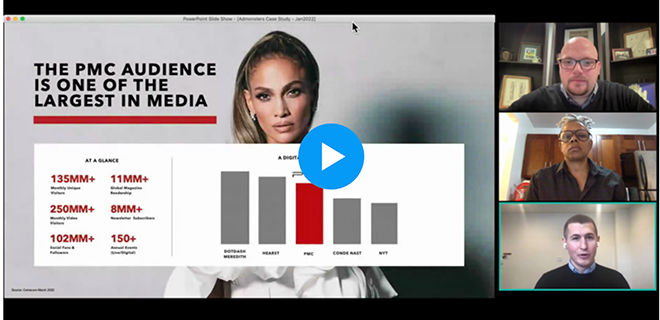
As regulations and privacy concerns continue to evolve and make third-party user data less usable for advertisers, many are looking toward first-party data as the future of gaining insight into what users want to accomplish online and leveraging it to drive revenue.
Companies not dependent on third-party cookies are at an advantage right now. They are less worried about the regulations coming down the pipeline in the future and are focused on building direct relationships with users visiting their sites.
In AdMonsters’ Jan. 25, 2023 webinar, “How PMC Drives Value for Advertisers,” we spoke with Brett Goverman, Head of Data Strategy, PMC, and Brendan Farrell, Manager, Customer Success, North America, Permutive. We discussed making the most of your first-party data, why campaigns using first-party data perform better, and how to uncover revenue insights to power more strategic partnerships with buyers.
[To view the full webinar, watch the video above.]
Having a First-Party Data Strategy
Goverman revealed that PMC recently launched ATLAS Data Studio, a first-party data strategy built to deliver unique insights to PMC’s brand partners. Unlike third-party data, Goverman notes, “With the development of a first-party data strategy, we sort of hold the keys to our own destiny, regardless of what regulators or browsers do.”
ATLAS Data Studio has four pillars:
- Contextual Analysis: Publishers need to understand which content is most impactful to their audiences. To assist with this, PMC partners with Permutive and IBM Watson to analyze web traffic across the company’s properties, to gain perspective on the most meaningful content to its audiences.
- Behavioral Signals: This helps separate the most engaged users from those who are not. In addition to tracking frequency and recency, this includes drilling down into ad clicks, video plays, video ad clicks, time on page, and other activities that truly represent how engaged a user is with a site.
- Proprietary Data Collection: This looks different for each publisher based on their strengths, but for PMC, it is about building relationships across brands through media such as newsletters, paid subscriptions, live events, digital events, and site surveys.
- Data Enrichment: This pillar appends and enriches partners’ data. For example, the studio includes data modeling or tools like cleanrooms where information is fed into ATLAS Data Studio and runs an analysis based on known facts about the audiences.
This data is valuable to advertising partners, and in a company as large as PMC, it raises awareness of overlapping demographics and custom audiences. For example, someone interested in parenting articles can also be interested in rock music. This data helps zero in on the target audience for specific products or content.
And for PMC, one of the most important elements of ATLAS Data Studio is that it allows advertising partners to extend their engagement to a cookie-blocked environment, leading to more effective campaigns.
Why First-party Is the Future of Data
Farrell shared that in the current environment where cookie blocking is already happening on browsers like Firefox and Safari, relying on third-party cookies means advertisers are potentially missing out on 70 percent of a publisher’s audience. Farrell said cookie data relies on demographic data or other data that functions outside of a direct relationship with the consumer and is overall very limiting.
Privacy is still a huge concern, however, when you talk about leveraging precise, granular data that users give to target them for specific products or events. PMC does its data collection in an anonymous, aggregate way rather than on an individual user basis to help partners understand key demographics they are missing out on.
And while companies like PMC are not collecting passive data on individuals, they ask for consent and data offered in exchange for some value to the user. That’s how first-party data relationships are really built.
This data is also useful for buyers. Goverman estimated that half the audience a buyer targets needs to be more effectively captured. Buyers must purchase twice the number of impressions to see the desired results. First-party data cuts out the middleman and leads to increased efficiency in campaigns.
PMC’s first-party data from 2022 led to the following:
- 5x better CTR than any other campaign
- 5x improvement in cost per acquisition
- Over 70% of impressions were from first-party data
- 46% increase in first-party data revenue year over year
These statistics highlight the value of first-party, authenticated data. First-party data increases engagement, provides the end user with a more valuable experience, saves money, and increases the quality of interaction for advertisers.
“This positions PMC as a far more strategic partner and makes it so our advertisers get full access and usability of our data. And that’s really the intent; how do we make our first party data as valuable and as sort of ‘interactional’ as possible? How do we make it so that advertisers can truly analyze and ingest this information in a way that fundamentally changes how they run their campaigns?” asserted Goverman.